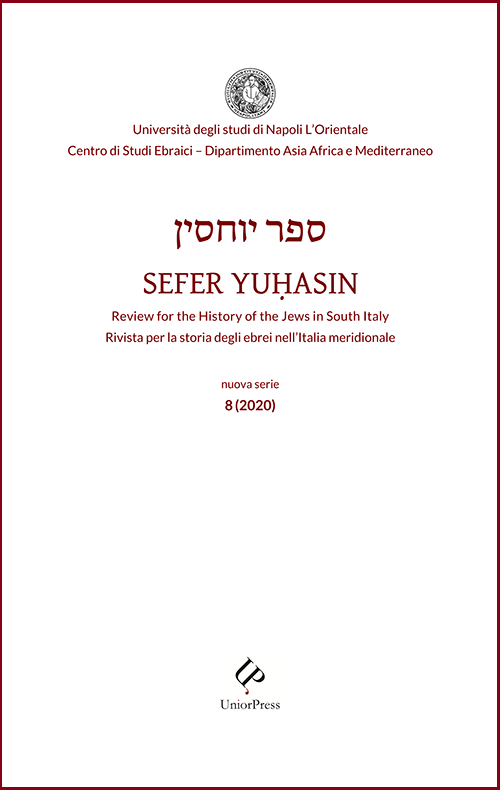The names of the Jews in Late Ancient Venosa: Latinization, rejudaization or rabbinization?
Abstract
I nomi degli ebrei nella Venosa tardoantica: latinizzazione, regiudaizzazione o rabbinizzazione?
La documentazione epigrafica ebraica della Venosa tardoantica (IV-VI secolo) è generalmente considerata come prova del processo di rabbinizzazione occorso in Italia in quel periodo. Chiari segni di una regiudaizzazione e/o rabbinizzazione consolidatasi nel IX secolo (che appare già altamente ebraizzato e rabbinizzato), sarebbero la maggiore presenza di parole ebraiche e di simboli ebraici e una maggior percentuale di nomi biblici rispetto a quanto si riscontra nelle catacombe ebraiche di Roma. In particolare, la menzione di due rabbini in una delle epigrafi della catacomba ebraica venosina, è spesso richiamata a conferma di questo assunto. In questo articolo si propone un'accurata analisi dei nomi portati dagli ebrei nella Venosa tardoantica, mettendone in luce non solo le percentuali, ma anche le pratiche onomastiche attestate nelle epigrafi. Confrontando i dati con l'onomasticon ebraico della diaspora occidentale e con quello non ebraico d'Italia, è possibile una riflessione su quali fossero i modelli condivisi e quelli non condivisi. La conclusione è che, almeno dal punto di vista onomastico, non è possibile confermare né un processo di regiudaizzazione né di rabbinizzazione, e che le pratiche onomastiche attestate nelle catacombe indicano piuttosto un processo di progressiva latinizzazione.
---
The Jewish epigraphical record of late ancient Venosa (4th – 6th centuries) is usually seen as proof of an ongoing rabbinization process in Italy. A greater presence of Hebrew words and Jewish symbols and a larger proportion of biblical names compared to the Jewish catacombs of Rome are presented as clear markers of a rejudaization or/and rabbinization that is consolidated by the 9th century (highly Hebraized and rabbinized) Venosan Jewish inscriptions. The mention of two rabbis in an inscription is frequently employed to confirm that conclusion. This article proposes a meticulous analysis of the names borne by the Jews in late ancient Venosa, highlighting not only proportions but also the naming practices attested in the inscriptions. Furthermore, comparisons with the Jewish onomasticon of the western Diaspora and the non-Jewish onomasticon of Italy allow us to ponder shared and non-shared patterns. The conclusion is that, at least from an onomastic point of view, neither rejudaization nor rabbinization can be verified, and that naming practices in the catacomb tend towards the Latinization of the names.
Downloads
Gli autori che pubblicano su questa rivista accettano le seguenti condizioni:
- Gli autori mantengono i diritti sulla loro opera e cedono alla rivista il diritto di prima pubblicazione dell'opera, contemporaneamente licenziata sotto una Licenza Creative Commons - Attribuzione che permette ad altri di condividere l'opera indicando la paternità intellettuale e la prima pubblicazione su questa rivista.
- Gli autori possono aderire ad altri accordi di licenza non esclusiva per la distribuzione della versione dell'opera pubblicata (es. depositarla in un archivio istituzionale o pubblicarla in una monografia), a patto di indicare che la prima pubblicazione è avvenuta su questa rivista.
- Gli autori possono diffondere la loro opera online (es. in repository istituzionali o nel loro sito web) prima e durante il processo di submission, poiché può portare a scambi produttivi e aumentare le citazioni dell'opera pubblicata (Vedi The Effect of Open Access).

